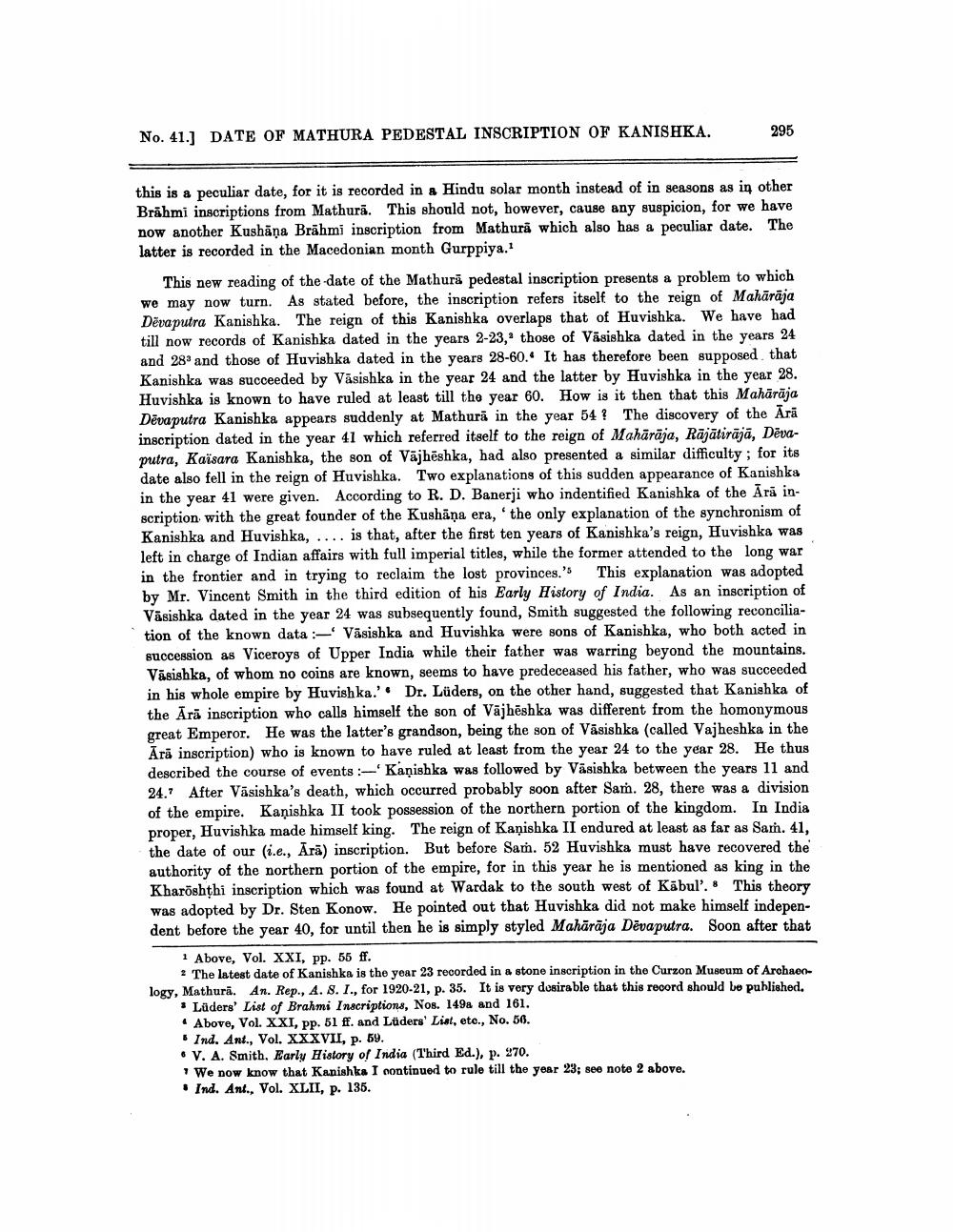________________
No. 41.] DATE OF MATHURA PEDESTAL INSCRIPTION OF KANISHKA.
295
this is a peculiar date, for it is recorded in a Hindu solar month instead of in seasons as in other Brahmi inscriptions from Mathura. This should not, however, cause any suspicion, for we have now another Kushāņa Brahmi inscription from Mathura which also has a peculiar date. The latter is recorded in the Macedonian month Gurppiya.1
This new reading of the date of the Mathura pedestal inscription presents a problem to which we may now turn. As stated before, the inscription refers itself to the reign of Mahārāja Devaputra Kanishka. The reign of this Kanishka overlaps that of Huvishka. We have had till now records of Kanishka dated in the years 2-23, those of Väsishka dated in the years 24 and 28 and those of Huvishka dated in the years 28-60. It has therefore been supposed that Kanishka was succeeded by Vasishka in the year 24 and the latter by Huvishka in the year 28. Huvishka is known to have ruled at least till the year 60. How is it then that this Mahārāja Devaputra Kanishka appears suddenly at Mathura in the year 54? The discovery of the Ārā inscription dated in the year 41 which referred itself to the reign of Mahārāja, Rājātirājā, Dēvaputra, Kaisara Kanishka, the son of Väjheshka, had also presented a similar difficulty; for its date also fell in the reign of Huvishka. Two explanations of this sudden appearance of Kanishka in the year 41 were given. According to R. D. Banerji who indentified Kanishka of the Ară inscription with the great founder of the Kushāņa era, the only explanation of the synchronism of Kanishka and Huvishka,.... is that, after the first ten years of Kanishka's reign, Huvishka was left in charge of Indian affairs with full imperial titles, while the former attended to the long war in the frontier and in trying to reclaim the lost provinces.'s This explanation was adopted by Mr. Vincent Smith in the third edition of his Early History of India. As an inscription of Väsishka dated in the year 24 was subsequently found, Smith suggested the following reconciliation of the known data :- Vasishka and Huvishka were sons of Kanishka, who both acted in succession as Viceroys of Upper India while their father was warring beyond the mountains. Vasishka, of whom no coins are known, seems to have predeceased his father, who was succeeded in his whole empire by Huvishka.' Dr. Lüders, on the other hand, suggested that Kanishka of the Ara inscription who calls himself the son of Vajheshka was different from the homonymous great Emperor. He was the latter's grandson, being the son of Vasishka (called Vajheshka in the Ara inscription) who is known to have ruled at least from the year 24 to the year 28. He thus described the course of events:- Kanishka was followed by Väsishka between the years 11 and 24. After Väsishka's death, which occurred probably soon after Sam. 28, there was a division of the empire. Kanishka II took possession of the northern portion of the kingdom. In India proper, Huvishka made himself king. The reign of Kanishka II endured at least as far as Sam. 41, the date of our (i.e., Ara) inscription. But before Sam. 52 Huvishka must have recovered the authority of the northern portion of the empire, for in this year he is mentioned as king in the Kharöshṭhi inscription which was found at Wardak to the south west of Kabul'. This theory was adopted by Dr. Sten Konow. He pointed out that Huvishka did not make himself independent before the year 40, for until then he is simply styled Mahārāja Devaputra. Soon after that
1 Above, Vol. XXI, pp. 55 ff.
2 The latest date of Kanishka is the year 23 recorded in a stone inscription in the Curzon Museum of Archaeology, Mathura. An. Rep., A. 8. I., for 1920-21, p. 35. It is very desirable that this record should be published.
Lüders' List of Brahmi Inscriptions, Nos. 149a and 161.
Above, Vol. XXI, pp. 51 ff. and Lüders' List, etc., No. 56.
Ind. Ant., Vol. XXXVII, p. 59.
V. A. Smith. Early History of India (Third Ed.), p. 270.
We now know that Kanishka I continued to rule till the year 23; see note 2 above. Ind. Ant., Vol. XLII, p. 135.




